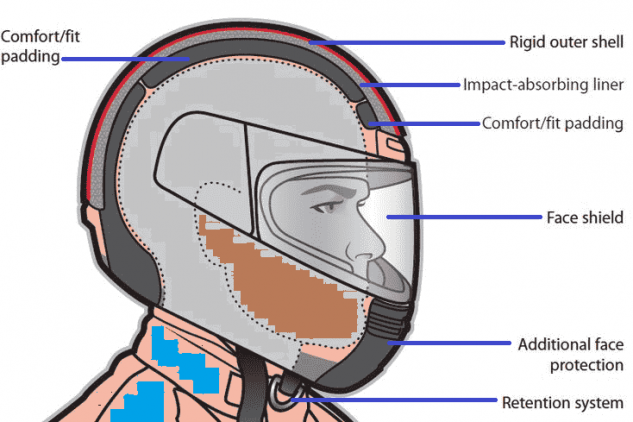
How to Choose the Best Helmet?
So, how do you select an appropriate helmet? What considerations should you make when purchasing a helmet? You must be familiar with a few fundamental details prior to entering the helmet store. We provide the fundamental information you need to keep in mind when purchasing a new helmet.
The majority of us ride two-wheelers for a variety of reasons; however, in order to make the best purchase, you must determine your primary expectation from the helmet. Do you intend to primarily use the helmet for your home-to-work commute? Or is it for long weekend rides? Or do you prefer to off-ride more?
Know your Head Size and Shape – Everybody has a unique personality and body shape, so it’s important to know what that is. There are primarily three types: the round oval, the intermediate oval, and the long oval. The same can be determined by observing the head structure on one’s own or by asking a friend to do the same. If the helmet you’re wearing is putting pressure in the wrong places on your head, you shouldn’t be riding with it at all. As a result, always wear a helmet and assess the pressure points on your head. When removed, a helmet of the appropriate size will not pull the skin off your face and scalp and will help prevent large movements, just like a crown would.
Retention – In the worst circumstances, helmets that stay on your head are thought to be the ones that will protect you; other helmets are just weights on your head. To confirm this, fasten the strap to your helmet and try to remove it from the back to see if it slides off your head. Adjust the strap if the helmet is rolling out, and if it still doesn’t stay where it should, it probably needs to be a better helmet for your ride. Half-faced and some modular helmets have a fundamental issue with retention; this should always be checked before purchasing a helmet.
Visor – When selecting a helmet, a visor is an additional essential component that should be taken into account. Because it is so important to have a clear vision, the visor needs to be clear. Smoked and mercury-tinted visors certainly draw customers’ attention, but they prevent clear vision and should be avoided. An anti-fog and anti-scratch visor is another wise investment for those with additional funds.
The Fit – If you were a kid and wore a helmet, you probably also remember that it used to move up and down. This demonstrates that the helmet is too big for you and does not fit. When testing a helmet, keep this in mind. The helmet should fit snugly and not try to suffocate you by being too tight or wobbling. If the helmet is too big or too loose, it will pop out in an accident. To find out how well it works for you, wear it for at least 10 to 15 minutes. The strap ought to secure itself and open easily, but not ambiguously. The helmet shouldn’t move or come out once it’s locked. You can check to see if the strap locks properly by asking someone else to take the helmet off for you.
Proper Cushioning – The inner cushioning of a helmet plays a crucial role in protecting your skull in the event of a crash or other fatal circumstance. If the inner surface of the helmet is flat, it will not be able to provide you with the level of protection that the helmet is designed to provide. Therefore, it must have adequate cushioning that is able to significantly absorb the force.
The Worth – The value ultimately comes down to the cost. Although Bell and Arai helmets costing twenty thousand a pop each sound impressive and desirable, you should look at what works best for you. It does not seem reasonable to spend that much on a motorcycle with 150-200 cc. In addition, helmets that meet the legal requirements for crash protection are available at reasonable prices. Beginning at a cost of Rs. From 3500/- and up, the market will offer a wide selection. You can get helmets for less money, but make sure they have the aforementioned features and would protect your head from impacts. Whether you spend money on a helmet or in a hospital is still entirely up to you.
The Certification – There is a certain standard or certification every helmet should have while you purchase them. Namely, SNELL CERTIFICATION, DOT (DEPARTMENT OF TRANSPORTATION), ECE (ECONOMIC COMMISSION OF EUROPE), and ISI (INDIAN STANDARDS INSTITUTE).
All these certifications are interlinked and are very similar to each other with changes that depend on resources. But make sure to wear a helmet that has a proper certification is necessary. The certifications are proof that the helmet you are wearing around your head is a safe, hence it should be protecting your head.
Always Have a Back-up – Always keep a spare helmet on hand in case something unexpected happens during a long-awaited weekend group ride, such as when a special person requests a lift or you need an extra helmet for a co-rider. A secondary helmet should be securely fastened to your two-wheeler for pillion riders because Indian law requires them to wear helmets on Indian roads.
P.S. Helmets don’t come in cheap, and their intended use cannot be overlooked. As a result, it’s critical that you ensure that the money you spend on a helmet is well spent once it’s on your head and keeps you safe while you ride.